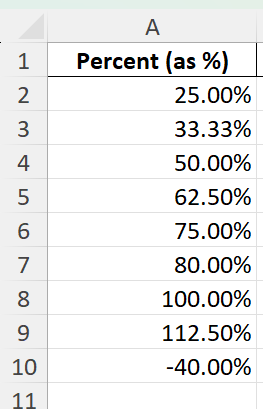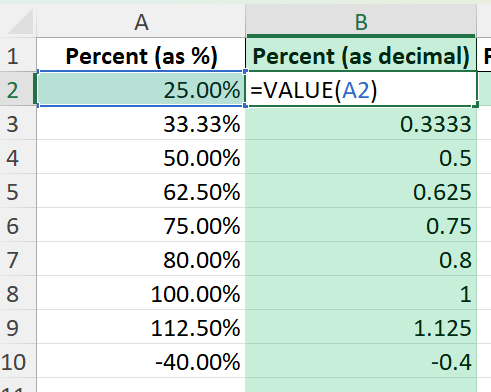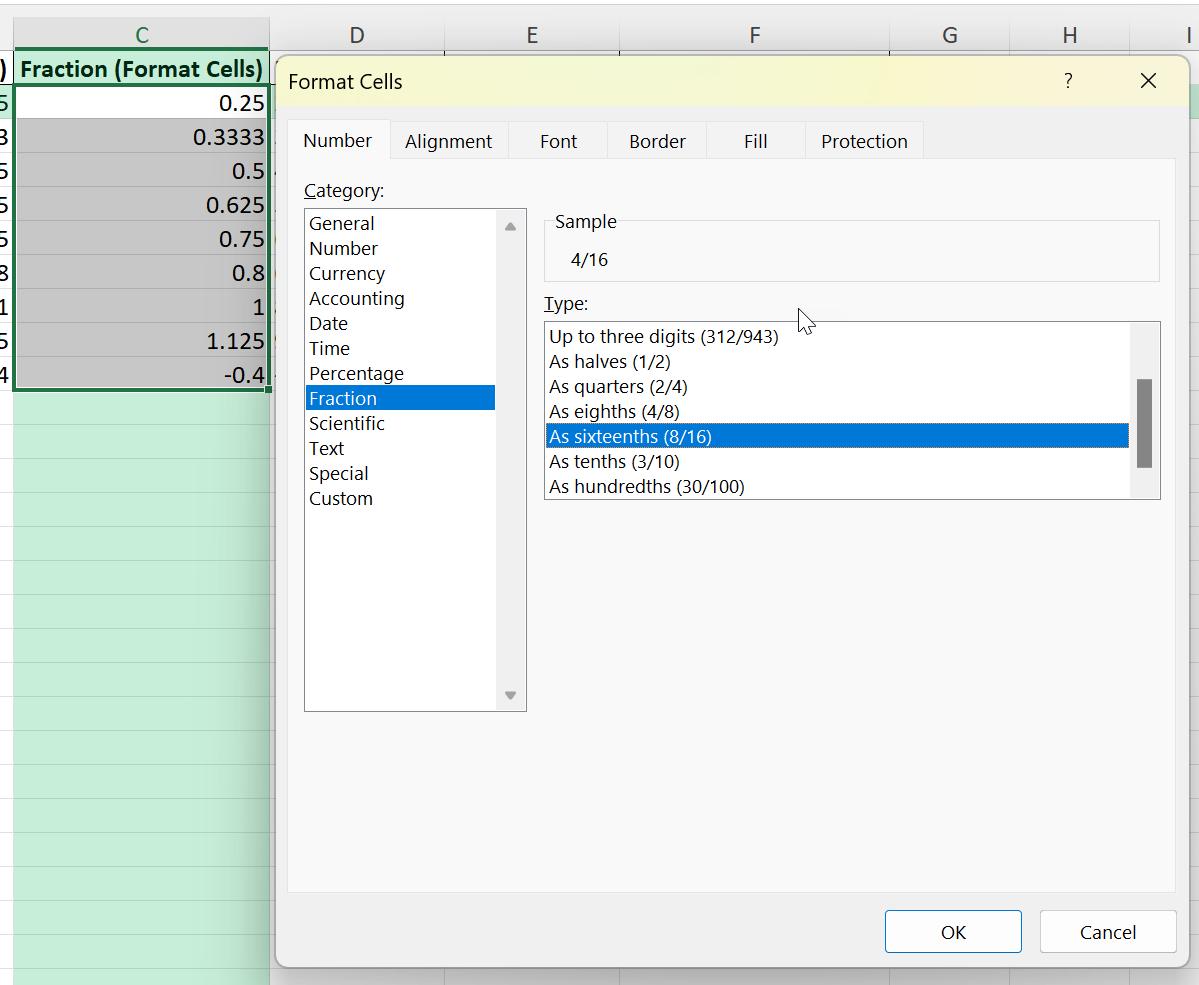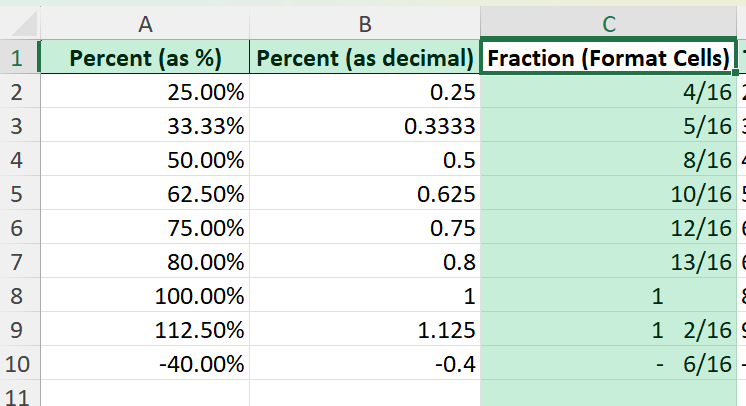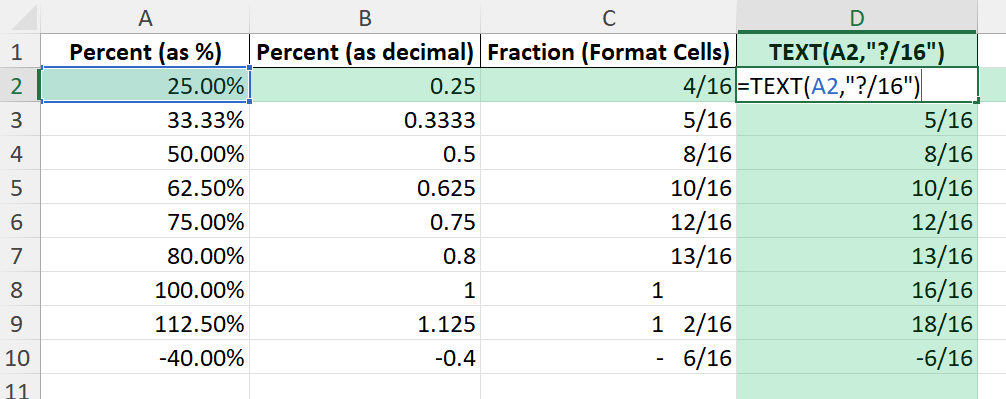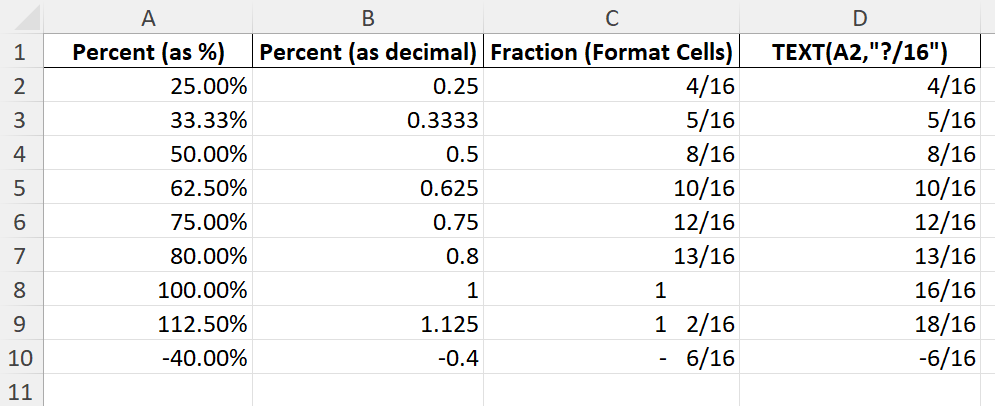Turning percentages into fractions in Excel is a common task in reporting, education, construction, and science. For example, you may want to show 75% as 3/4, or 12.5% as 1/8. Excel can quickly convert and format percentages as fractions, allowing you to display your results exactly how your audience needs. This guide explains multiple ways to turn a percent into a fraction, with formulas, formatting, and advanced tips.
Key Takeaways
- Excel can format decimal or percentage values as readable fractions (e.g., 0.75 as 3/4).
- You can use Format Cells > Fraction, or formulas like
TEXT(), for full control. - Convert percentages to decimals first (e.g., 45% → 0.45) for correct fraction formatting.
- Helper columns or VBA macros can automate conversion and rounding to standard denominators.
- Use Power Query for batch processing or integrating with larger data workflows.
Table of Contents
Understanding Fractions and Percentages
The Basics of Fraction-to-Percentage Conversion
When dealing with Excel, understanding the relationship between fractions and percentages is crucial. A percentage represents a fraction of 100, while a fraction is a way to express parts of a whole. To convert a percentage to a fraction, divide the percentage by 100 and simplify if needed. For example, 75% becomes 75/100, which simplifies to 3/4. Recognizing this conversion is essential for accurate data analysis and presentation.
Why Convert Percentages into Fractions?
Converting percentages into fractions can provide greater clarity and precision in data representation, especially when working with datasets where simple ratios are more intuitive than percentages. Fractions allow for better comparisons in financial calculations, probability assessments, and when scaling data. Furthermore, in many scientific and engineering contexts, fractions simplify the interpretation of results and make calculations more straightforward.
About Turning Percent into a Fraction in Excel
Percentages and fractions both represent parts of a whole, but they are shown differently: 50% is the same as 1/2, 33.33% is about 1/3. In Excel, converting a percentage into a fraction helps in academic grading, measurements, recipes, and financial analysis.
- 75% → 3/4
- 25% → 1/4
- 80% → 4/5
You can convert using simple formulas or built-in formatting, depending on your needs.
How to Convert a Percent to a Fraction in Excel
Step 1: Enter Your Percent Data
Type your percentages in column A (e.g., 25%, 33.33%, 50%, 75%).
If your data is in decimal format (e.g., 0.25), you can skip to Step 3.
Step 2: Convert Percent to Decimal (if needed)
To convert a percent (e.g., 75%) to decimal, use:
=A2
If formatted as percent, Excel already treats it as decimal in calculations (e.g., 75% = 0.75 internally).
If entered as text (e.g., “75%”), convert with:
=VALUE(A2)
Step 3: Format as Fraction
Select the decimal numbers or percentages.
Right-click > Format Cells > Number tab > Fraction.
Choose the type, such as “Up to one digit (1/4)”, “Up to two digits (21/25)”, or “As eighths (4/8)”.
Click OK. Your values now show as fractions (e.g., 0.75 → 3/4).
Step 4: Use the TEXT Function for Custom Fraction Output
To display a decimal as a fraction in a helper column, use:
=TEXT(A2,"?/8")
This shows 0.125 as “1/8”, 0.75 as “6/8” (can adjust denominator as needed).
To round to common denominators (quarters, eighths, etc.):
=TEXT(A2,"?/4") or =TEXT(A2,"?/16")
Common Mistakes and Tips
Mistake: Not converting percent to decimal first
Applying fraction formatting to 75 (not 0.75) will give 75/1, not 3/4.
Mistake: Formatting as General or Number, not Fraction
Only the Fraction format or TEXT() function shows fractions as desired.
Tip: Use helper columns for calculations
Keep raw percent, decimal, and fraction columns for easy checks.
Tip: Round to nearest common fraction
Adjust the denominator in formatting or TEXT() for quarters, eighths, sixteenths, etc.
Tip: For fractions over 1 (e.g., 150%), display as mixed number
Use =INT(A2)&" "&TEXT(A2-INT(A2),"?/4") to show 1 1/2 for 150%.
Bonus Tips and Advanced Scenarios
Automate with VBA Macro
Function PercentToFraction(val As Double, denominator As Integer) As String
Dim numer As Integer
numer = Application.WorksheetFunction.MRound(val * denominator, 1)
PercentToFraction = numer & "/" & denominator
End Function
Use =PercentToFraction(A2,8) to round to eighths.
Power Query for Batch Conversion
Load data to Power Query and add a custom column with formula:
Number.Round([Percent]*8)/8
Then add a text column for fraction display.
Visualize with Conditional Formatting
Color-code fractions for quick analysis (e.g., highlight all 1/2 or greater).
Advanced Techniques for Efficient Conversion
Applying Excel Shortcuts
Excel shortcuts can significantly streamline the process of converting percentages to fractions. You can use keyboard shortcuts to quickly access formatting options. For instance, select the cell with the percentage, and use the shortcut Ctrl + 1 to open the format cells menu. In the numbers tab, select ‘Fraction’ to instantly convert and display the percentage as a fraction. Mastering these shortcuts not only speeds up your workflow but also reduces the likelihood of errors.
Automating the Process with Formulas
Automating percentage to fraction conversions in Excel with formulas simplifies data manipulation and enhances efficiency. Use the formula =TEXT(A1/100, "# ?/?") where A1 contains the percentage. This converts the percentage to a fraction and outputs it in a readable format. Automation reduces manual entry, increases consistency across datasets, and ensures quicker, more reliable calculations.
Error-Proofing Your Workbook
Ensuring accuracy in Excel workbooks is crucial, especially when converting percentages to fractions. One effective method is using data validation to prevent incorrect inputs by setting rules that restrict percentage entries to a specific range. Additionally, employing conditional formatting can highlight cells where conversions don’t fit expected criteria, alerting you to potential errors. Regularly using the ‘Review’ tab for error-check features helps catch mistakes early.
FAQ
Q: Why does my fraction not look correct?
A: Make sure you have converted your percent to a decimal before applying fraction formatting.
Q: Can I set which denominator to use?
A: Yes, use Format Cells > Fraction > “As eighths”, “As sixteenths”, or use TEXT() with your chosen denominator.
Q: How do I show fractions greater than 1?
A: Use =INT(A2)&" "&TEXT(A2-INT(A2),"?/4") for mixed numbers.
Q: Will this work with negative percentages?
A: Yes, Excel handles negative numbers in both formatting and formulas.
Q: Can I automate all conversions for large data sets?
A: Yes, use Power Query or the VBA macro to automate conversion.
John Michaloudis is a former accountant and finance analyst at General Electric, a Microsoft MVP since 2020, an Amazon #1 bestselling author of 4 Microsoft Excel books and teacher of Microsoft Excel & Office over at his flagship MyExcelOnline Academy Online Course.

